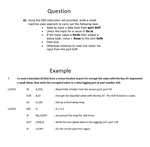Jason12345
Newbie level 5

Hi, i have a question on computer architecture and its very difficult. My college teacher said the example given has alot of what we need to figure it out so ill post that along with the question as an image
So far i have...
I know its wrong but i cant get my head around it, does anyone have any ideas? anything is appreciated

also if you need the z80 instruction set, here is a link to it - https://clrhome.org/table/
So far i have...
Code:
IN A, (0xff)
XOR A, 0x1b
JP LOOP1
OUT (0xfb), 0xaaI know its wrong but i cant get my head around it, does anyone have any ideas? anything is appreciated

also if you need the z80 instruction set, here is a link to it - https://clrhome.org/table/

